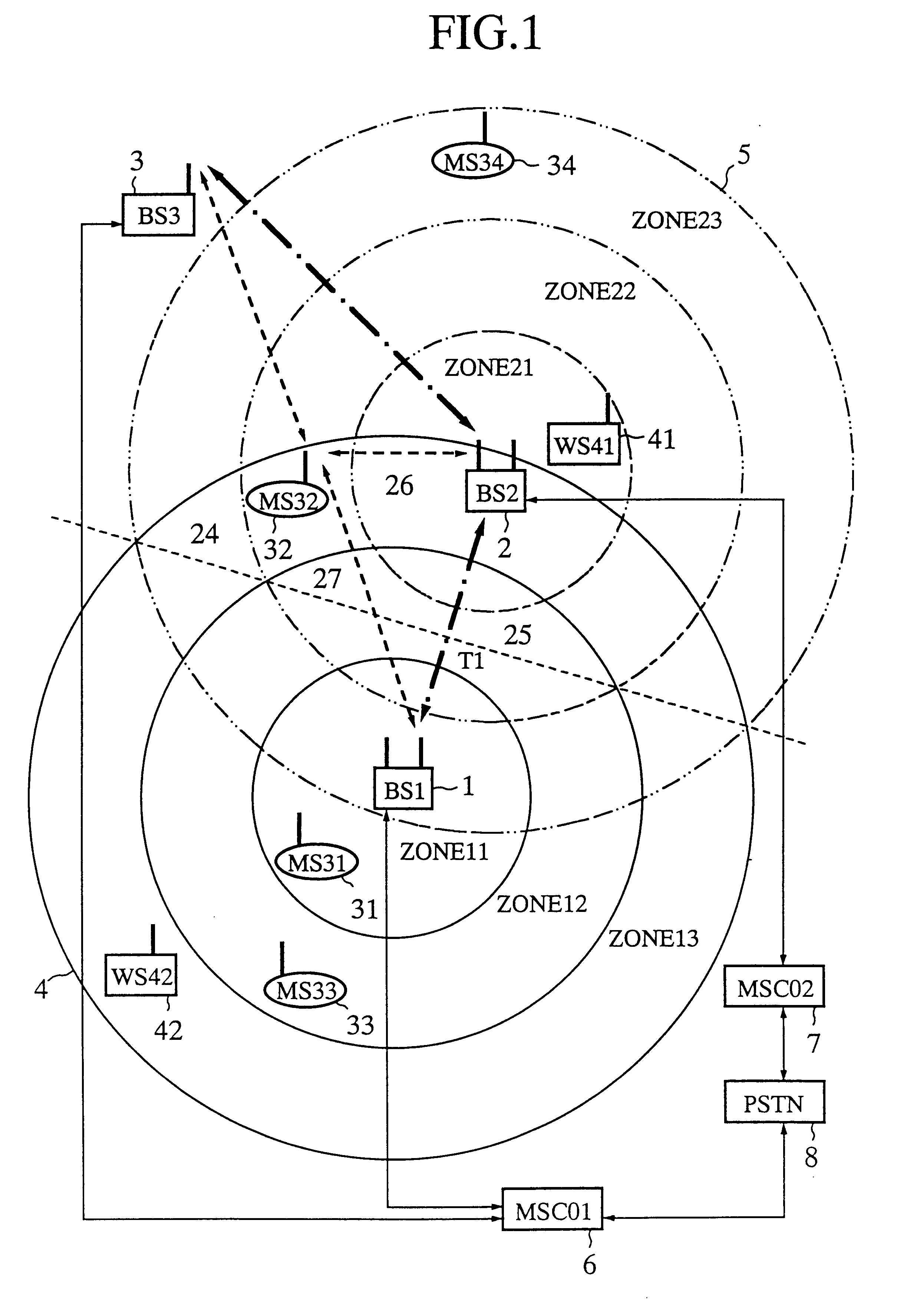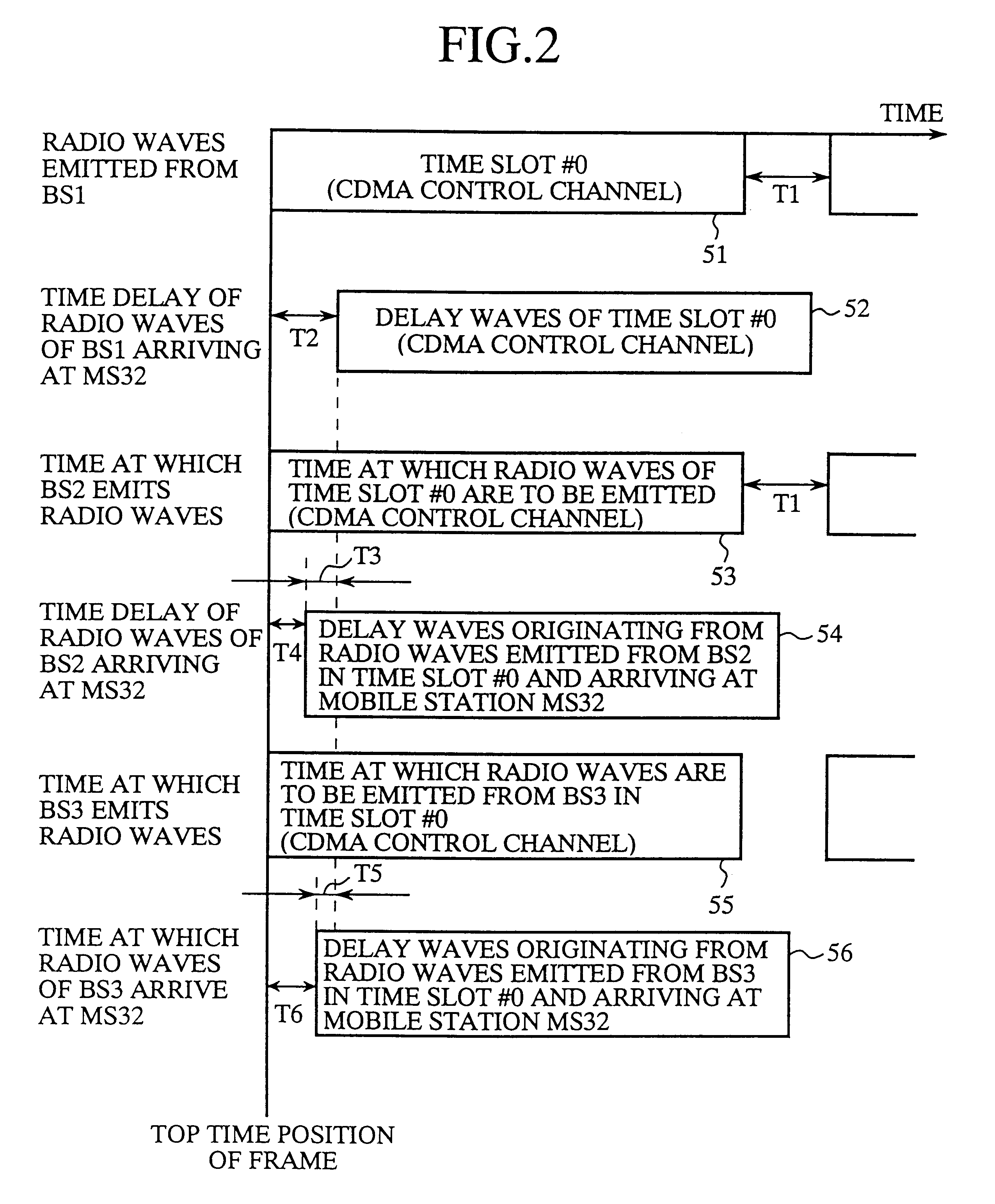Mobile communication system
a mobile communication and system technology, applied in multiplex communication, wireless communication, synchronisation arrangement, etc., can solve the problems of not involving the measurement of distance, the method of handling, and the frame synchronization of the chip plate unit, so as to measure the distance between the radio base station and the mobile station
- Summary
- Abstract
- Description
- Claims
- Application Information
AI Technical Summary
Benefits of technology
Problems solved by technology
Method used
Image
Examples
embodiment 1
FIG. 1 is a system constructive view showing a general construction of a mobile communication system to which a time slot sharing and frequency channel sharing system according to the present invention is applied. Referring to FIG. 1, reference numerals 1, 2 and 3 denote each a radio base station, and 4 and 5 denote each a radio cover area (hereinafter referred to as cell) constructed by the radio base station 1 or 2. It is to be noted that the cell 4 includes zones 11, 12 and 13, and the cell 5 includes zones 21, 22 and 23. Reference numerals 31, 32, 33 and 34 denote each a mobile station (MS) such as a mobile vehicle carried communication apparatus, a mobile portable communication apparatus or the like which communicates with the radio base station 1 or 2 over a radio channel. Reference numerals 41 and 42 denote each a WLL station (WS) which communicates with the radio base station 1 or 2 over a radio channel.
Reference numeral 6 denotes a mobile switching center (MSC) which contro...
embodiment 2
Subsequently, as an embodiment 2 of the present invention, measurement of the distance to a moving mobile station in a time-divided CDMA system is described.
FIG. 7 is a diagrammatic view illustrating an example of a frame structure of a TDMA / time-divided CDMA communication system for a PCS in the present embodiment 2. This frame structure is similar to that of the PHS (Personal Handy Phone System: a cordless system used in Japan), but is a little different in structure of time slots. In particular, the voice codec rate is assumed to be 16 kb / s, 8 kb / s or 4 kb / s. The data transmission rate is 192 kb / s, and the information rate per one time slot is 23.2 kb / s. By setting the chip rate to 192 kb / s.times.128=24.576 Mb / s, data of 192 kb / s mentioned above are spectrum-spreaded with orthogonal spread-spectrum codes having this chip rate. Accordingly, a plurality of time-divided CDMA signals having different orthogonal spread-spectrum codes in one time slot share a frequency channel, and the...
embodiment 3
Subsequently, as an embodiment 3 of the present embodiment, a mobile station hand-over system under a condition that radio base stations are installed not at equal distances is described.
Hand-over which changes over a mobile station to the nearest radio base station is usually performed based on electric field strengths of received signals from the mobile station or radio base stations.
However, in a mobile communication system in which the distances between radio base stations are not necessarily equal to each other such as where radio base stations of different operators are installed in a mixed condition and cells (radio cover areas) of them overlap with each other or where a large number of radio base stations are installed in a arrow area because of the communication loads, the following situation exists: it cannot be discriminated that the distance from a mobile station to a neighboring radio base station is shortest when the transmission power to the mobile station or the radi...
PUM
 Login to View More
Login to View More Abstract
Description
Claims
Application Information
 Login to View More
Login to View More - R&D
- Intellectual Property
- Life Sciences
- Materials
- Tech Scout
- Unparalleled Data Quality
- Higher Quality Content
- 60% Fewer Hallucinations
Browse by: Latest US Patents, China's latest patents, Technical Efficacy Thesaurus, Application Domain, Technology Topic, Popular Technical Reports.
© 2025 PatSnap. All rights reserved.Legal|Privacy policy|Modern Slavery Act Transparency Statement|Sitemap|About US| Contact US: help@patsnap.com



